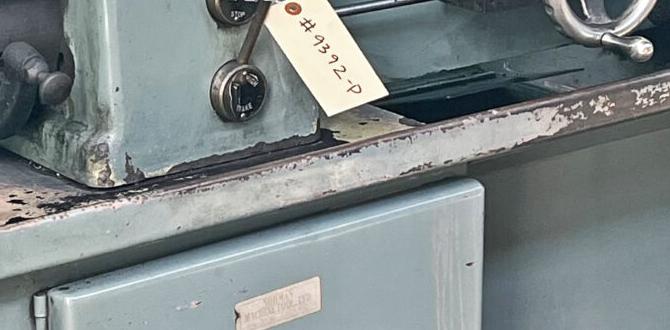Carbide end mills, especially 1/8 inch with a 6mm shank and standard length, are absolutely essential for efficient and precise Delrin machining, delivering clean cuts and excellent results for hobbyists and professionals alike.
Welcome, fellow makers! Ever tried to machine Delrin (also known as Acetal or POM) and ended up with gummy, stringy messes instead of clean cuts? It’s a common frustration when you’re starting out. Delrin is a fantastic plastic – strong, slippery, and easy to work with once you get the hang of it. The secret often lies in the right cutting tool, and that’s where a 1/8 inch carbide end mill truly shines. Don’t worry, getting those perfect cuts is easier than you think. We’ll break down exactly why this specific tool is your new best friend for Delrin projects and show you just how to use it for those smooth, professional finishes. Let’s dive in and unlock your Delrin machining potential!
What Kind of End Mill Do You Need for Delrin?
When it comes to machining plastics like Delrin, selecting the right cutting tool is crucial for achieving clean, chip-free cuts and preventing melting or material buildup on the cutter. While various end mills can technically cut Delrin, certain types are far superior for this specific material.
The key characteristics to look for in an end mill for Delrin are:
- Material: Carbide is generally the preferred material for machining plastics like Delrin. It’s harder and stays sharper than High-Speed Steel (HSS), which helps in achieving cleaner cuts and resisting heat buildup.
- Flute Count: For plastics, fewer flutes are often better. Two-flute or three-flute end mills are typically recommended for Delrin. The wider chip gullets (the space between the flutes) in fewer-flute tools allow chips to evacuate more easily, reducing the chance of them re-cutting and causing a gummy mess.
- Rake Angle: A higher positive rake angle helps the cutting edge shear the material more cleanly, reducing the force required and minimizing heat generation. This is especially beneficial for softer plastics.
- Sharpness: The sharper the end mill, the better the cut in Delrin. Dull tools will drag and melt the plastic rather than cutting it.
While specialized plastic cutters exist, a standard 1/8 inch carbide end mill, particularly one designed for general-purpose machining, will often perform admirably on Delrin if used with the correct parameters.
Why a 1/8 Inch Carbide End Mill is Your Go-To for Delrin
So, why is a 1/8 inch carbide end mill so often recommended for Delrin? It boils down to a combination of size, material properties, and versatility.
Size Matters: The Versatility of 1/8 Inch
A 1/8 inch (approximately 3.175mm) cutting diameter is a sweet spot for many Delrin projects, especially in home workshops and for hobbyists.
- Detail Work: This size is perfect for smaller features, intricate patterns, text engraving, and creating detailed components without removing too much material at once.
- Manageable Chip Load: A smaller diameter means you can use finer chip loads, which is beneficial for plastics to prevent overheating and melting.
- Material Removal Rate: While not for hogging out large amounts of material quickly, it allows for controlled material removal, which is often desired when working with plastics to maintain accuracy.
- Accessibility: 1/8 inch end mills are widely available, making them an accessible tool for most machinists.
Carbide Advantages
As mentioned, carbide is a top choice for a reason:
- Heat Resistance: Delrin can melt if too much heat is generated. Carbide’s superior heat resistance helps it cut through the plastic without softening or deforming as quickly as HSS.
- Edge Retention: Carbide holds a sharp edge for much longer than HSS. This means more consistent cuts over time, especially important when accuracy is key.
- Rigidity: Carbide is a harder and more rigid material, which translates to less tool deflection and more precise cuts.
Shank Size and Length Considerations
When you see “1/8 inch carbide end mill 6mm shank standard length,” it tells you a few vital things about the tool:
- 1/8 Inch Cutting Diameter: This is the business end, the part that does the cutting.
- 6mm Shank: This is the diameter of the tool shank that will be held in your milling machine’s collet or tool holder. A 6mm shank is common for many smaller end mills and fits a wide range of collet sizes. Ensure your milling machine can accommodate this.
- Standard Length: This refers to the overall length and flute length of the end mill. A standard design usually balances rigidity (shorter tools are stiffer) with reach (longer tools can access deeper features). For most Delrin work where you’re not deep in a cavity, a standard length is perfectly suitable.
- Low Runout: This specification is critical. It means the end mill is manufactured to very tight tolerances so that when it spins in the collet, its cutting edges don’t wobble excessively. Low runout is vital for achieving smooth surface finishes and accurate dimensions, especially with small diameter tools, and is highly desirable for plastics.
Essential Setup for Machining Delrin with Your 1/8 Inch End Mill
Before you even think about hitting the “go” button on your CNC or turning the crank on your manual mill, proper setup is paramount for success and safety.
Securing Your Workpiece (Delrin)
Delrin is a relatively soft plastic, so it needs firm but gentle clamping. Overtightening can deform the material, leading to inaccurate parts or even cracking.
- Workholding Options:
- Vise: A good quality vise with soft jaws (made of plastic, aluminum, or wood) is ideal. This prevents marring the surface of the Delrin. Make sure the jaws are parallel to avoid putting uneven pressure on the part.
- Double-Sided Tape: For thinner or smaller parts, strong double-sided foam mounting tape can surprisingly work well, especially on clean, flat surfaces. Ensure adequate tape coverage.
- Fixturing: For production runs or more complex parts, designing a custom fixture is the best approach. This could be a simple block with cutouts or an impressively engineered jig.
- Clamping Pressure: Apply just enough pressure to prevent the part from moving during the cut. You should be able to just feel resistance if you try to nudge the workpiece by hand.
- Support: Ensure the Delrin workpiece is fully supported underneath, especially near the cutting area, to prevent flexing.
Collet and Spindle Check
The connection between the end mill and the spindle is another critical point.
- Cleanliness: Ensure the collet and the inside of the spindle taper are spotless. Dust, chips, or coolant residue can cause runout and lead to poor finish and tool breakage.
- Collet Fit: Make sure the 6mm shank of your end mill fits snugly into the appropriate collet. A slight tap with a plastic mallet can seat it properly.
- Runout: Even with a good end mill, a worn collet or spindle can introduce runout. If you’re getting poor finish, consider checking your machine’s runout with an indicator.
A correctly seated tool in a clean, precise collet is the foundation of accurate machining.
Machining Parameters for Delrin: Achieving a Perfect Cut
This is where the magic happens. Setting the right speed and feed is arguably the most crucial aspect of machining Delrin successfully with your 1/8 inch carbide end mill. The goal is to shear the plastic cleanly, allow chips to escape, and avoid frictional heat.
Speeds and Feeds: The Sweet Spot
Delrin machines best at relatively high surface speeds with moderate feed rates.
- Surface Speed (SFM): For carbide cutters in Delrin, a good starting point for surface speed is often in the range of 200-400 SFM (Surface Feet per Minute).
- Spindle Speed (RPM): You’ll need to calculate this based on your end mill diameter and the desired surface speed. The formula is:
RPM = (SFM 12) / (π Diameter)For a 1/8 inch (0.125 inch) end mill aiming for 300 SFM:
RPM = (300 12) / (3.14159 0.125) ≈ 9167 RPMThis is a high RPM, so ensure your milling machine can achieve it. If not, you’ll need to adjust your SFM downwards or accept a slightly less optimal cut.
- Feed Rate (IPM): The feed rate determines how fast the tool moves through the material. A too-fast feed will cause chatter or tool breakage, while a too-slow feed will increase heat. For a 1/8 inch end mill in Delrin, a chip load of around 0.001 to 0.003 inches per tooth is a good starting point.
Feed Rate (IPM) = Chip Load (inches/tooth) Number of Flutes RPMUsing our example of 9167 RPM with a 2-flute end mill and aiming for a 0.0015 inch chip load:
Feed Rate = 0.0015 2 9167 ≈ 27.5 IPMThis is a relatively slow feed rate, which is common for small diameter cutters and plastics to ensure a good finish and prevent overheating.
- Stepdown (Depth of Cut): For better chip evacuation and to reduce the load on the tool, it’s often best to take lighter depth cuts. A stepdown of 0.0625 inches (half the tool diameter) or even less is usually a good starting point for profiling or pocketing. For finishing passes, you might take an even lighter cut.
- Stepover (Width of Cut): When milling slots or pockets, the stepover refers to how much the tool moves sideways for each pass. For high-quality surface finish, a stepover of 25-50% of the tool diameter is common. For roughing, you might go wider.
Important Note: These are starting points! Always listen to your machine and the cutting sound. If you hear squealing, it might be too fast or too dry. If you hear clattering or chatter, it might be too slow or the material is flexing.
Coolant and Lubrication
Delrin machining generates heat. While it’s a plastic and can melt, it doesn’t have the same cutting fluid requirements as metal.
- Compressed Air: A blast of compressed air is often the best “coolant” for Delrin. It blows chips away and helps keep the cutting area cool without introducing potentially messy or reactive liquids.
- Flood Coolant (Carefully): If using flood coolant or a mist system, use a minimal amount. Too much liquid can sometimes make Delrin chips gummy if they become saturated. Ensure your coolant is compatible with plastics.
- Dry Machining: For many small Delrin parts, you might not need any additional cooling. Just rely on sharp tools and good air blast.
Chip Evacuation
This cannot be stressed enough. Delrin chips can be stringy and prone to re-cutting if they don’t get out of the flutes quickly.
- Air Blast: As mentioned, this is your best friend. Position a nozzle to blow air directly into the cut and across the flutes of the end mill.
- Peck Drilling/Pocketing: If plunging into the material or pocketing deep, use a “pecking” motion. Rapidly retract the tool slightly at intervals to clear chips from the hole or pocket.
- Fewer Flutes: As discussed, 2-flute or 3-flute end mills have larger chip gullets, which aid evacuatio
n significantly.
Step-by-Step: Machining a Simple Delrin Part
Let’s walk through machining a basic part, like a small bracket or a gear blank, from a Delrin sheet.
Step 1: Design and CAM Programming (if applicable)
- Design your part in CAD software. Keep in mind the limitations of your 1/8 inch end mill – very small internal corners will have a radius equal to the tool’s radius (1/16 inch or 1.5875mm).
- If using a CNC, generate your toolpaths in CAM software.
- Select your 1/8 inch, 2-flute, carbide end mill.
- Input appropriate speeds and feeds (start with the mid-range of our recommendations).
- Define toolpaths for roughing (e.g., pocketing, contouring) and finishing. It’s often good practice to use a separate finishing pass with a lighter cut and perhaps a slightly higher feed rate for optimal surface finish.
- Ensure your toolpath strategy accommodates effective chip evacuation.
Step 2: Material Preparation and Workholding
- Ensure your Delrin stock is flat and clean.
- Secure the Delrin to your milling machine bed or vise using appropriate workholding methods (soft jaws, tape, fixture).
- Double-check that the workpiece is rigid and won’t vibrate or move during machining.
Step 3: Tool Installation and Z-Zeroing
- Install the 1/8 inch carbide end mill into your collet and tighten it securely in the spindle.
- Bring the tip of the end mill down to the surface of your Delrin workpiece.
- Set your Z-axis zero point accurately. This is critical for controlling cutting depth. A touch probe or a simple edge finder can be used here.
Step 4: Running the Machining Program (or Manual Machining)
- CNC:
- Load your program.
- Turn on your air blast or mist coolant.
- Perform an “air cut” first – run the entire program a few inches above the material to verify tool movements and potential collisions.
- Initiate the program on the material.
- Monitor the cutting process closely, especially for chip buildup or unusual sounds. Be ready to hit the emergency stop if needed.
- Manual Mill:
- Set your spindle speed.
- Engage the spindle.
- Slowly feed the end mill into the material, taking light depth-of-cut passes.
- Use your handwheel to move the X and Y axes, following your part’s design.
- Ensure good chip clearing as you go.
Step 5: Finishing Passes
- If you programmed separate finishing passes, let them run. These typically involve a very light depth of cut and a slightly higher feed rate to create a smooth surface finish.
- For manual machining, a final light pass around the perimeter should suffice.
Step 6: Part Removal and Inspection
- Once the machining is complete, disengage the spindle.
- Carefully remove any remaining chips from the part and machine.
- Unclamp and remove your newly machined Delrin part.
- Inspect the part for accuracy, surface finish, and any signs of melting or deformation.
Troubleshooting Common Delrin Machining Issues
Even with the right tools and setup, you might encounter a few snags. Here’s how to address them.
Gummy, Stringy Chips
This is the most common problem.
- Cause: Heat buildup, dull tool, too slow feed rate, or insufficient chip evacuation.
- Solution:
- Increase spindle speed (if possible) or decrease surface speed.
- Slow down feed rate slightly to get a better chip load.
- Ensure your compressed air is hitting the cut effectively.
- Use a sharper end mill or one designed for plastics (higher rake angle).
- Employ pecking cycles for plunging operations.
- Reduce depth of cut.
Melting or Softening of the Material
- Cause: Excessive heat generation, usually due to friction.
- Solution:
- Reduce spindle speed.
- Increase feed rate slightly.
- Use compressed air or mist coolant.
- Take lighter depth-of-cut passes.
- Ensure the tool is not rubbing but cutting.
Poor Surface Finish (Scalloping, Roughness)
- Cause: Tool deflection, worn tool, machine rigidity issues, or incorrect feed/speed.
- Solution:
- Use a shorter, more rigid end mill if possible (though your 1/8 inch standard length is usually okay).
- Ensure your workpiece is well-supported.
- Use






